A Critical Review of Sustainable Energy Policies for the Promotion of Renewable Energy Sources
Abstract
1. Introduction
2. Framework of Sustainable Energy Policy
2.1. United States of America Energy Policy Context
2.2. Germany Energy Policy Context
2.3. United Kingdom Energy Policy Context
2.4. Denmark Energy Policy Context
2.5. China Energy Policy Context
3. Modelling Sustainable Energy Policy
- Effectiveness (Extent to which the objectives are met);
- Efficiency (Innovation with decrease in costs);
- Equity (Fair distribution of the rents between RE developer and government);
- Institutional feasibility (Extent political support is provided to the policy);
- Replicability (Extent to which the policy can be adopted in other countries).
4. Effective Policies for Promotion of Sustainable Energy
- Delivering adequate and affordable energy supplies
- Encouraging energy efficiency
- Accelerating the use of new renewables
- Widening the diffusion and use of other advanced energy technologies
4.1. Energy Efficiency Standard (EES)
4.2. Feed-in-Tariff (FiT)
4.3. Building Energy Performance Certification (BEPC) Schemes
5. Concluding Remarks
- (1)
- Establish a trustworthy and reliable database system for policy analysisA new energy policy is usually proposed based on the current technology and related database system. To avoid incorrect input data, it is also important to ensure that quality and accuracy of the data in the database is not compromised. Information transfer can be tracked using technologies such as Blockchain Technology. Only a highly reliable database can benefit from effective design of future energy policy and the development of corresponding building renovation strategies. Based on the database system, when and where the policy implementation requires adjustment (e.g., the adjustment of energy-efficiency standards for building materials) can be identified by national and local authorities.
- (2)
- Increase information transparency and provide recommendations for building energy saving measuresThe database should contain at least the basic information, e.g., building type, year of construction, floor area, heated floor area, energy consumption per year, energy label, carbon emission, energy-saving recommendations, as well as the information about the energy assessor. The information updated after renovation should be recorded in the documents over the lifetime of a building. Some aspects of the databases should be accessible to the public to create a user-friendly data-sharing platform for authorities, research entities, homeowners and prospective owners or renters. This can assist them to compare with the assessment from another representative dwelling in the same block and reinforce public awareness of energy efficiency. Recommendations for energy-saving measures significantly influence homeowners’ decisions. Optimised and cost-effective upgradation of the building performance with estimates of energy saving should encourage the homeowners to consider upgradation. Personalised instructions on renovation options to quantify energy savings and related costs can be included in a related energy label certificate such as green building certificate or EPCs.
- (3)
- Provide financial support for building renovationIt is a priority to retrofit the existing building stock for energy saving. However, two major reasons hinder the building-owners from implementing refurbishment: additional costs for energy-saving measures, and a lack of knowledge of the financial benefits after renovation. The refurbishment entails the improvement of building envelope thermal performance as well as the replacement of the old heating systems. Buildings that meet a certain energy level after renovation can be rewarded by subsidies to reduce the perceived risks of investing in energy-efficiency measures.
- (4)
- Develop reward-penalty mechanism for promoting net-zero energy buildingsIt is still a challenge to achieve the target of net-zero energy buildings for all new buildings by the end of 2020 if no financial support is provided. It is therefore necessary to design the reward-penalty mechanism for further promoting net-zero energy buildings. The parameters affecting reward-penalty function should be firstly identified, and different types of reward-penalty function can be further designed and validated. The reward-penalty mechanism can be developed based on annual assessment, monthly assessment or daily assessment. The daily reward-penalty mechanism is supposed to be more effective and efficient to provide incentives for building-owners to actively manage their energy usages.
- (5)
- Encourage the application of smart devices to achieve future smart buildings/citiesThe use of electronic devices and HVAC system contribute significantly to the building energy performance, which is difficult to quantify as the occupants’ behaviors and preference (e.g., internal temperature, hours of operation) are difficult to forecast. The adoption of smart devices can increase energy efficiency and facilitate building energy monitoring, and it is important to ensure the inclusion of these systems in policy development. Indicators like smart readiness indicator can be developed to stimulate investors for technological innovation and promote smart devices in buildings. A great uptake of smart capabilities, such as building automation and control system, smart meters and self-regulation devices will pave the way for future smart buildings and smart cities.
Author Contributions
Funding
Conflicts of Interest
References
- U.S. Energy Information Administration. Energy information administration, Total Energy. Available online: http://www.eia.gov/totalenergy/ (accessed on 12 February 2020).
- Pachauri, R.K.; Allen, M.R.; Barros, V.R.; Broome, J.; Cramer, W.; Christ, R.; Church, J.A.; Clarke, L.; Dahe, Q.; Dasgupta, P. Climate Change 2014: Synthesis Report. Contribution of Working Groups I, II and III to the fifth Assessment Report of the Intergovernmental Panel on Climate Change; IPCC: Geneva, Switzerland, 2014. [Google Scholar]
- Giorgetta, M.A.; Jungclaus, J.; Reick, C.H.; Legutke, S.; Bader, J.; Böttinger, M.; Brovkin, V.; Crueger, T.; Esch, M.; Fieg, K. Climate and carbon cycle changes from 1850 to 2100 in MPI-ESM simulations for the Coupled Model Intercomparison Project phase 5. J. Adv. Modeling Earth Syst. 2013, 5, 572–597. [Google Scholar] [CrossRef]
- Doyle, A. Climate change fight affordable, cut emissions to zero by 2100. Mail Online, 2 November 2014. Available online: http://www.reuters.com/article/2014/11/02/climatechange-report-idUSL6N0SS0B820141102 (accessed on 7 May 2015).
- Fortuński, B. Sustainable Development and Energy Policy: Actual CO2 Emissions in the European Union in the Years 1997–2017, Considering Trade with China and the USA. Sustainability 2020, 12, 3363. [Google Scholar] [CrossRef]
- Goldthau, A. The Handbook of Global Energy Policy; John Wiley & Sons: Hoboken, NJ, USA, 2016. [Google Scholar]
- Smith, D.W.; Nordhaus, R.R.; Roberts, T.C.; Fidler, S.; Anderson, J.; Danish, K.; Agnew, R.; Chupka, M. Designing a climate-friendly energy policy: Options for the Near Term. 2002. Available online: https://trid.trb.org/view/723994 (accessed on 10 June 2020).
- European Commission. A European Green Deal: Striving to be the First Climate-Neutral Continent; European Commission: Brussels, Belgium, 2019. [Google Scholar]
- Löschel, A. European Green Deal und deutsche Energiewende zusammen denken! Wirtschaftsdienst 2020, 100, 78–79. [Google Scholar] [CrossRef][Green Version]
- Claeys, G.; Tagliapietra, S.; Zachmann, G. How to make the European Green Deal work. Bruegel Policy Contrib. 2019, 13, 21. [Google Scholar]
- Maya-Drysdale, D.; Jensen, L.K.; Mathiesen, B.V. Energy Vision Strategies for the EU Green New Deal: A Case Study of European Cities. Energies 2020, 13, 2194. [Google Scholar] [CrossRef]
- United Nations Framework Convention on Climate Change. Adoption of the Paris Agreement FCCC/CP/2015/L. 9/Rev. 1; United Nations: Geneva, Switzerland, 2015. [Google Scholar]
- Blok, K. Enhanced policies for the improvement of electricity efficiencies. Energy Policy 2005, 33, 1635–1641. [Google Scholar] [CrossRef]
- Lund, H. Implementation of energy-conservation policies: The case of electric heating conversion in Denmark. Appl. Energy 1999, 64, 117–127. [Google Scholar] [CrossRef]
- Lior, N. Advanced energy conversion to power. Energy Convers. Manag. 1997, 38, 941–955. [Google Scholar] [CrossRef]
- Lior, N. Thoughts about future power generation systems and the role of exergy analysis in their development. Energy Convers. Manag. 2002, 43, 1187–1198. [Google Scholar] [CrossRef]
- Afgan, N.H.; Carvalho, M.G. Multi-criteria assessment of new and renewable energy power plants. Energy 2002, 27, 739–755. [Google Scholar] [CrossRef]
- Afgan, N.H.; Carvalho, M.G. Sustainability assessment of hydrogen energy systems. Int. J. Hydrog. Energy 2004, 29, 1327–1342. [Google Scholar] [CrossRef]
- Global Carbon Atlas. Available online: http://www.globalcarbonatlas.org/en/CO2-emissions (accessed on 27 May 2020).
- Net Zero: The Scorecard. 2020. Available online: https://eciu.net/analysis/briefings/net-zero/net-zero-the-scorecard (accessed on 29 May 2020).
- Bohi, D.R.; Russell, M. Limiting Oil Imports: An Economic History and Analysis; Routledge: London, UK, 2013. [Google Scholar]
- Solomon, B.D.; Krishna, K. The coming sustainable energy transition: History, strategies, and outlook. Energy Policy 2011, 39, 7422–7431. [Google Scholar] [CrossRef]
- Mallon, K. Renewable Energy Policy and Politics: A Handbook for Decision-Making; Earthscan: London, UK, 2006. [Google Scholar]
- International Energy Agency. World Energy Outlook 2018. Available online: https://www.iea.org/reports/world-energy-outlook-2018; (accessed on 18 December 2019).
- International Energy Agency. World Energy Outlook 2019. Available online: https://www.iea.org/reports/world-energy-outlook-2019 (accessed on 2 January 2020).
- Energy Policy Act of 2005; Government Printing Office: Washington, DC, USA, 2005.
- Dixon, R.K.; McGowan, E.; Onysko, G.; Scheer, R.M. US energy conservation and efficiency policies: Challenges and opportunities. Energy Policy 2010, 38, 6398–6408. [Google Scholar] [CrossRef]
- Energiebilanzen, A. Energieverbrauch in Deutschland im Jahre 2015; AGEB Energieverbrauch in Deutschland: Berlin, Germany, 2016. [Google Scholar]
- Renn, O.; Marshall, J.P. Coal, nuclear and renewable energy policies in Germany: From the 1950s to the “Energiewende”. Energy Policy 2016, 99, 224–232. [Google Scholar] [CrossRef]
- Chapter 27. In Crown 2008 Climate Change Act 2008; The Stationary Office Limited: London, UK, 2008. Available online: http://www.opsi.gov.uk/acts/acts2008/pdf/ukpga_20080027_en.pdf (accessed on 29 March 2020).
- European Union. Directive 2009/28/EC of the European Parliament and of the Council of 23 April 2009 on the promotion of the use of energy from renewable sources and amending and subsequently repealing Directives 2001/77/EC and 2003/30/EC. Off. J. Eur. Union 2009, 5, 2009. [Google Scholar]
- The Climate Change Act 2008 (2050 Target Amendment) Order 2019. 2020. Available online: https://www.legislation.gov.uk/uksi/2019/1056/article/1/made (accessed on 19 April 2020).
- Cameron, A.; Claeys, G.; Midões, C.; Tagliapietra, S. How Good is the European Commission’s Just Transition Fund Proposal? Bruegel Policy Contribution Issue n° 4. 2020. Available online: http://aei.pitt.edu/102554/1/PC-04_2020-V2.pdf (accessed on 4 April 2020).
- McAllister, P.; Nase, I. The impact of Minimum Energy Efficiency Standards: Some evidence from the London office market. Energy Policy 2019, 132, 714–722. [Google Scholar] [CrossRef]
- McBurney, S. Ofgem: Administering CERT and CESP, DEKB Conference—“Making It Happen”. Available online: www.dekb.co.uk/Steve%20McBurney.pdf (accessed on 14 November 2010).
- Mallaburn, P.S.; Eyre, N. Lessons from energy efficiency policy and programmesin the UK from 1973 to 2013. Energy Effic. 2014, 7, 23–41. [Google Scholar] [CrossRef]
- Hough, D.; Bolton, P.; Richards, P. The Warm Home Discount Scheme; House of Commons Library: London, UK, 2011. [Google Scholar]
- UK Government. UK Government, Budget 2011; HM Treasury: London, UK, 2011.
- Department of Energy. The Green Deal: A summary of the Government’s Proposals; Department of Energy: Washington, DC, USA, 2010.
- Bureau, C.A. The Green Deal and Energy Company Obligation, Citizens Advice Response to Department for Energy and Climate Change; Citizens Advice: London, UK, 2012. [Google Scholar]
- Energy Act, U.P.G.A. UK Parliamentary Legislation. 2008. Available online: http://www.legislation.gov.uk/ukpga/2008/32/contents (accessed on 5 May 2020).
- Pollitt, M.G. The role of policy in energy transitions: Lessons from the energy liberalisation era. Energy Policy 2012, 50, 128–137. [Google Scholar] [CrossRef]
- Department of Energy & Climate Change. Renewable Heat Incentive; Department of Energy & Climate Change: London, UK, 2011.
- Department of Energy & Climate Change. Renewable Heat Incentive (rhi) Scheme; Update 11 June 2012; Department of Energy & Climate Change: London, UK, 2012.
- National Renewable Energy Action Plan for the United Kingdom: Article 4 of the Renewable Energy Directive 2009/28/EC; Under Obligation Article; UK Government: London, UK, 2010; Volume 4.
- Saidur, R.; Islam, M.; Rahim, N.; Solangi, K. A review on global wind energy policy. Renew. Sustain. Energy Rev. 2010, 14, 1744–1762. [Google Scholar] [CrossRef]
- Mendonça, M.; Lacey, S.; Hvelplund, F. Stability, participation and transparency in renewable energy policy: Lessons from Denmark and the United States. Policy Soc. 2009, 27, 379–398. [Google Scholar] [CrossRef]
- Danish Energy Agency. Rapport fra Arbejdsgruppen om Kraftvarme-og VE-Elektricitet (Report from the Expertgroup on CHP- and RES-Electricity); Danish Energy Agency: Copenhagen, Denmark, 2001.
- Lund, H.; Munster, E. AAU’s analyser (Aalborg University Analyses). In Bilagsrapport fra Arbejdsgruppen om Kraftvarme-og VE-Elektricitet (Attachment Report from the Expertgroup on CHP- and RES-Electricity); Danish Energy Agency: Copenhagen, Denmark, 2001; p. 35. [Google Scholar]
- Danish Academy of Technical Sciences. “Wind power 2—proposal for an active programme”; Danish Academy of Technical Sciences: Copenhagen, Denmark, 1976. (in Danish) [Google Scholar]
- Meyer, N.I. Development of Danish wind power market. Energy Environ. 2004, 15, 657–673. [Google Scholar] [CrossRef]
- Ratinen, M.; Lund, P. Policy inclusiveness and niche development: Examples from wind energy and photovoltaics in Denmark, Germany, Finland, and Spain. Energy Res. Soc. Sci. 2015, 6, 136–145. [Google Scholar] [CrossRef]
- Bureau, B.C. Design standard for energy efficiency of public buildings. 2015. Available online: http://bbs.topenergy.org/ (accessed on 5 May 2016).
- Design Standards for Energy Efficiency of Residential Buildings in cold and frigid Zone. Energy Build. 2010, 36, 1309–1312.
- Design Standard for Energy Efficiency of Residential Building in Hot Summer and Cold Winter Zone; Ministry of Construction: Beijing, China, 2010.
- Design Standard for Energy Efficiency of Residential Building in Hot Hummer and Warm Winter Zone; Ministry of Construction: Beijing, China, 2012.
- Zhang, M.; Zhou, D.; Zhou, P.; Chen, H. Optimal design of subsidy to stimulate renewable energy investments: The case of China. Renew. Sustain. Energy Rev. 2017, 71, 873–883. [Google Scholar] [CrossRef]
- Yatsui, T. China’s Energy Policy and Related Issues Towards 2020; Mitsui Global Strategic Studies Institute Monthly Report; Mitsui Global Strategic Studies Institute: Tokyo, Japan, 2017. [Google Scholar]
- Si, S.; Lyu, M.; Lawell, C.-Y.C.L.; Chen, S. The effects of energy-related policies on energy consumption in China. Energy Econ. 2018, 76, 202–227. [Google Scholar] [CrossRef]
- Liu, J. China’s renewable energy law and policy: A critical review. Renew. Sustain. Energy Rev. 2019, 99, 212–219. [Google Scholar] [CrossRef]
- Mitchell, C.; Sawin, J.; Pokharel, G.; Kammen, D.; Wang, Z.; Fifita, S.; Jaccard, M.; Langniss, O.; Lucas, H.; Nadai, A.; et al. Policy, Financing and Implementation IPCC Special Report on Renewable Energy Sources and Climate Change Mitigation; Cambridge University Press: Cambridge, UK, 2011. [Google Scholar]
- Gungah, A.; Emodi, N.V.; Dioha, M.O. Improving Nigeria’s renewable energy policy design: A case study approach. Energy Policy 2019, 130, 89–100. [Google Scholar] [CrossRef]
- Qudrat-Ullah, H. Modelling and simulation in service of energy policy. Energy Procedia 2015, 75, 2819–2825. [Google Scholar] [CrossRef]
- Foell, W.K. Energy planning in developing countries. Energy Policy 1985, 13, 350–354. [Google Scholar] [CrossRef]
- Fishbone, L.G.; Abilock, H. Markal, a linear-programming model for energy systems analysis: Technical description of the bnl version. Int. J. Energy Res. 1981, 5, 353–375. [Google Scholar] [CrossRef]
- Omu, A.; Choudhary, R.; Boies, A. Distributed energy resource system optimisation using mixed integer linear programming. Energy Policy 2013, 61, 249–266. [Google Scholar] [CrossRef]
- Kydes, A.S.; Shaw, S.H. The National Energy Modelling System: Policy Analysis and Forecasting at the US Department of Energy; U.S. Department of Energy, Office of Scientific and Technical Information: Washington, DC, USA, 1997. [Google Scholar]
- Praetorius, B.; Schumacher, K. Greenhouse gas mitigation in a carbon constrained world: The role of carbon capture and storage. Energy Policy 2009, 37, 5081–5093. [Google Scholar] [CrossRef]
- Wood, F.P.; Geinzer, J.C. The IDEAS model and its use in developing the US climate change action plan. In Systems Modeling Energy Policy; Wiley: Chichester, UK, 1997; pp. 31–46. [Google Scholar]
- Meier, P.; Mubayi, V. Modelling energy-economic interactions in developing countries: A linear programming approach. Eur. J. Oper. Res. 1983, 13, 41–59. [Google Scholar] [CrossRef]
- Islas, J.; Grande, G. Optimization of alternative options for SO2 emissions control in the Mexican electrical sector. Energy Policy 2007, 35, 4495–4503. [Google Scholar] [CrossRef]
- Munasinghe, M.; Meier, P. Energy Policy Analysis and Modelling; Cambridge University Press: Cambridge, UK, 1993. [Google Scholar]
- Amlin, J.S. Simulation of greenhouse gas cap-and-trade systems with energy 2020. In Energy Policy Modeling in the 21st Century; Springer: New York, NY, USA, 2013; pp. 107–122. [Google Scholar]
- Qudrat-Ullah, H. Energy Policy Modeling in the 21st Century; Springer: New York, NY, USA, 2013. [Google Scholar]
- Zhang, M.; Zhou, D.; Zhou, P.; Liu, G. Optimal feed-in tariff for solar photovoltaic power generation in China: A real options analysis. Energy Policy 2016, 97, 181–192. [Google Scholar] [CrossRef]
- Ritzenhofen, I.; Spinler, S. Optimal design of feed-in-tariffs to stimulate renewable energy investments under regulatory uncertainty—A real options analysis. Energy Econ. 2016, 53, 76–89. [Google Scholar] [CrossRef]
- Hitaj, C.; Löschel, A. The impact of a feed-in tariff on wind power development in Germany. Resour. Energy Econ. 2019, 57, 18–35. [Google Scholar] [CrossRef]
- Yang, C.; Ge, Z. Dynamic feed-in tariff pricing model of distributed photovoltaic generation in China. Energy Procedia 2018, 152, 27–32. [Google Scholar] [CrossRef]
- Lu, Y.; Zhang, X.; Huang, Z.; Wang, D.; Zhang, Y. Penalty-cost-based design optimization of renewable energy system for net zero energy buildings. Energy Procedia 2018, 147, 7–14. [Google Scholar] [CrossRef]
- Lu, Y.; Zhang, X.-P.; Li, J.; Huang, Z.; Wang, C.; Luo, L. Design of a reward-penalty cost for the promotion of net-zero energy buildings. Energy 2019, 180, 36–49. [Google Scholar] [CrossRef]
- Md, M.I.; Sun, Z.; Dagli, C. Reward/penalty design in demand response for mitigating overgeneration considering the benefits from both manufacturers and utility company. Proc. Comput. Sci. 2017, 114, 425–432. [Google Scholar]
- Wu, J.; Albrecht, J.; Fan, Y.; Xia, Y. The design of renewable support schemes and CO2 emissions in China. Energy Policy 2016, 99, 4–11. [Google Scholar] [CrossRef]
- Obrecht, M.; Denac, M. A study of key factors for energy policy modelling. Naše Gospod. Our Econ. 2012, 58, 28–37. [Google Scholar] [CrossRef]
- Qudrat-Ullah, H.; Davidsen, P.I. Understanding the dynamics of electricity supply, resources and pollution: Pakistan’s case. Energy 2001, 26, 595–606. [Google Scholar] [CrossRef]
- Peter, R.; Dickie, L.; Peter, V.M. Adoption of photovoltaic power supply systems: A study of key determinants in India. Renew. Energy 2006, 31, 2272–2283. [Google Scholar] [CrossRef]
- Qudrat-Ullah, H.; Seong, B.S. How to do structural validity of a system dynamics type simulation model: The case of an energy policy model. Energy Policy 2010, 38, 2216–2224. [Google Scholar] [CrossRef]
- Trappey, A.J.; Trappey, C.V.; Hsiao, C.-T.; Ou, J.J.; Chang, C.-T. System dynamics modelling of product carbon footprint life cycles for collaborative green supply chains. Int. J. Comput. Integr. Manuf. 2012, 25, 934–945. [Google Scholar] [CrossRef]
- Jan, T.; Hsiao, C. A four-role model of the automotive industry development in developing countries: A case in Taiwan. J. Oper. Res. Soc. 2004, 55, 1145–1155. [Google Scholar] [CrossRef]
- Trappey, C.V.; Trappey, A.J.; Lin, G.Y.; Chang, Y.-S. System dynamics evaluation of renewable energy policies. In Improving Complex Systems Today; Springer: New York, NY, USA, 2011; pp. 133–140. [Google Scholar]
- Mutingi, M.; Matope, S. System dynamics of renewable energy technology adoption. In Proceedings of the 2013 IEEE International Conference on Industrial Technology (ICIT), Cape Town, South Africa, 25–28 February 2013; pp. 1512–1516. [Google Scholar]
- Mutingi, M.; Mbohwa, C. Fuzzy system dynamics: A framework for modeling renewable energy policies. In Energy Policy Modeling in the 21st Century; Springer: New York, NY, USA, 2013; pp. 31–47. [Google Scholar]
- Jebaraj, S.; Iniyan, S. A review of energy models. Renew. Sustain. Energy Rev. 2006, 10, 281–311. [Google Scholar] [CrossRef]
- Jefferson, M. Energy Policies for Sustainable Development; UNDP: London, UK, 2000. [Google Scholar]
- Wiel, S.; McMahon, J.E. Governments should implement energy-efficiency standards and labels—Cautiously. Energy Policy 2003, 31, 1403–1415. [Google Scholar] [CrossRef]
- Chandel, S.; Sharma, A.; Marwaha, B.M. Review of energy efficiency initiatives and regulations for residential buildings in India. Renew. Sustain. Energy Rev. 2016, 54, 1443–1458. [Google Scholar] [CrossRef]
- BCA 2010-6 Star NatHERS Rating for Buildings; IEA: Canaberra, Australia, 2019.
- Instituto Nacional de Metrologia, Normalizaçao e Qualidade Industrial. RegulamentoTécnico da Qualidade Para o Nívelde Eficiência energética Edificações Residenciais (RTQ-R); Portaria n.18, de 16 de janeiro de 2012; INMETRO: Rio de Janeiro, Brazil, 2012; (In Portuguese).
- National Research Council Canada. National Energy Code of Canada for Buildings; National Research Council Canada: Ottawa, ON, Canada, 2017. [Google Scholar]
- Yuan, X.; Zhang, X.; Liang, J.; Wang, Q.; Zuo, J. The development of building energy conservation in china: A review and critical assessment from the perspective of policy and institutional system. Sustainability 2017, 9, 1654. [Google Scholar] [CrossRef]
- Vergne, F. RT2012: Unsurcoût de Construction de 15–20%. 2001. Available online: http://www.lemoniteur.fr/190-metiers/article/actualite/775575-rt-2012-unsurcout-de-construction-de-15-20 (accessed on 1 June 2014).
- Energieeinsparverordnung, EnEV; Vwew Energieverlag GmbH: Offenbach am Main, Germany, 2014.
- EU Energy Performance of Buildings Directive (EPBD); European Commission: Brussels, Belgium, 2018.
- Yu, S.; Evans, M.; Delgado, A. Energy code enforcement and compliance evaluation: Comparative lessons learned from the US and China, and opportunities for India. In Proceedings of the ACEEE2014 Summer Study on Energy Efficiency in Buildings, Pacific Grove, CA, USA, 18–22 August 2014. [Google Scholar]
- Girgis-McEwen, E.; Ullah, R. Energy efficiency measures for net-zero energy ready building codes. In Proceedings of the eSim 2018, the 10th conference of IBPSA, Montreal, QC, Canada, 9–10 May 2018. [Google Scholar]
- Regulation and Licensing Department. New Mexico Energy Conservation Code; Regulation and Licensing Department: Quezon, Mexico, 2009.
- New Zealand Building Code (NZBC)—Clause H1; Building Performance: Wellington, New Zealand, 2015.
- Presidential Decree 2012, State Programme on Energy Savings; President’s Office: Moscow, Russia, 2010.
- South African National Standard SANS 0204: Energy Efficiency in Buildings; SABS: Capetown, South Africa, 2011.
- Building Design Criteria for Energy Saving (BDCES); BCAP: Seul, Korea, 2008.
- Technical Building Code 2007 (Royal Decree 314/2006 of 17 March 2006). Available online: https://www.global-regulation.com/translation/spain/1446654/royal-decree-314-2006%252c-of-march-17%252c-which-approves-the-technical-building-code.html (accessed on 2 December 2009).
- Conservation of fuel and power: Approved Document L. Available online: https://www.gov.uk/government/publications/conservation-of-fuel-and-power-approved-document-l (accessed on 18 January 2020).
- International Code Council. International Residential Code (IRC); International Code Council: Washington, DC, USA, 2018. [Google Scholar]
- Couture, T.D.; Cory, K.; Kreycik, C.; Williams, E. Policymaker’s Guide to Feed-in Tariff Policy Design; National Renewable Energy Lab.: Golden, CO, USA, 2010. [Google Scholar]
- Mendonça, M. Feed-in Tariffs: Accelerating the Deployment of Renewable Energy; Routledge: London, UK, 2009. [Google Scholar]
- Harris, F.; Navarro, P. Policy Options for Promoting Wind Energy Development in California: A Report to the Governor and State Legislature; University of California: Irvine, CA, USA, 1999. [Google Scholar]
- Hirsh, R.F. PURPA: The spur to competition and utility restructuring. Electr. J. 1999, 12, 60–72. [Google Scholar] [CrossRef]
- Xia, F.; Lu, X.; Song, F. The role of feed-in tariff in the curtailment of wind power in China. Energy Econ. 2020, 86, 104661. [Google Scholar] [CrossRef]
- Ofgem. Feed-In Tariff (FIT) Rates. Available online: https://www.ofgem.gov.uk/environmental-programmes/fit/fit-tariff-rates (accessed on 5 February 2020).
- Moore, S.; Durant, V.; Mabee, W.E. Determining appropriate feed-in tariff rates to promote biomass-to-electricity generation in Eastern Ontario, Canada. Energy Policy 2013, 63, 607–613. [Google Scholar] [CrossRef]
- Lan, H.; Cheng, B.; Gou, Z.; Yu, R. An evaluation of feed-in tariffs for promoting household solar energy adoption in Southeast Queensland, Australia. Sustain. Cities Soc. 2020, 53, 101942. [Google Scholar] [CrossRef]
- Buckman, G.; Sibley, J.; Ward, M. The large-scale feed-in tariff reverse auction scheme in the Australian Capital Territory 2012, to 2016. Renew. Energy 2019, 132, 176–185. [Google Scholar] [CrossRef]
- Schmidt, J.; Lehecka, G.; Gass, V.; Schmid, E. Where the wind blows: Assessing the effect of fixed and premium based feed-in tariffs on the spatial diversification of wind turbines. Energy Econ. 2013, 40, 269–276. [Google Scholar] [CrossRef]
- Pacudan, R. Feed-in tariff vs incentivized self-consumption: Options for residential solar PV policy in Brunei Darussalam. Renew. Energy 2018, 122, 362–374. [Google Scholar] [CrossRef]
- Zhang, R.X.X.; Ni, M.; Shen, G.Q.; Wong, J.K. An analysis on the effectiveness and determinants of the wind power Feed-in-Tariff policy at China’s national-level and regional-grid-level. Sustain. Energy Technol. Assess. 2019, 34, 87–96. [Google Scholar] [CrossRef]
- Du, Y.; Takeuchi, K. Does a small difference make a difference? Impact of feed-in tariff on renewable power generation in China. Energy Econ. 2020, 87, 104710. [Google Scholar] [CrossRef]
- Kitzing, L. Risk implications of renewable support instruments: Comparative analysis of feed-in tariffs and premiums using a mean–variance approach. Energy 2014, 64, 495–505. [Google Scholar] [CrossRef]
- Grover, D.; Daniels, B. Social equity issues in the distribution of feed-in tariff policy benefits: A cross sectional analysis from England and Wales using spatial census and policy data. Energy Policy 2017, 106, 255–265. [Google Scholar] [CrossRef]
- Kwon, T.-H. Policy mix of renewable portfolio standards, feed-in tariffs, and auctions in South Korea: Are three better than one? Util. Policy 2020, 64, 101056. [Google Scholar] [CrossRef]
- Ramírez, F.J.; Honrubia-Escribano, A.; Gómez-Lázaro, E.; Pham, D.T. Combining feed-in tariffs and net-metering schemes to balance development in adoption of photovoltaic energy: Comparative economic assessment and policy implications for European countries. Energy Policy 2017, 102, 440–452. [Google Scholar] [CrossRef]
- Winter, S.; Schlesewsky, L. The German feed-in tariff revisited-an empirical investigation on its distributional effects. Energy Policy 2019, 132, 344–356. [Google Scholar] [CrossRef]
- Caralis, G.; Chaviaropoulos, P.; Albacete, V.R.; Diakoulaki, D.; Kotroni, V.; Lagouvardos, K.; Gao, Z.; Zervos, A.; Rados, K. Lessons learnt from the evaluation of the feed-in tariff scheme for offshore wind farms in Greece using a Monte Carlo approach. J. Wind Eng. Ind. Aerodyn. 2016, 157, 63–75. [Google Scholar] [CrossRef]
- Tomar, V.; Tiwari, G. Techno-economic evaluation of grid connected PV system for households with feed in tariff and time of day tariff regulation in New Delhi—A sustainable approach. Renew. Sustain. Energy Rev. 2017, 70, 822–835. [Google Scholar] [CrossRef]
- Bakhshi, R.; Sadeh, J. Economic evaluation of grid–connected photovoltaic systems viability under a new dynamic feed–in tariff scheme: A case study in Iran. Renew. Energy 2018, 119, 354–364. [Google Scholar] [CrossRef]
- Lau, K.; Muhamad, N.; Arief, Y.; Tan, C.; Yatim, A. Grid-connected photovoltaic systems for Malaysian residential sector: Effects of component costs, feed-in tariffs, and carbon taxes. Energy 2016, 102, 65–82. [Google Scholar] [CrossRef]
- Marques, A.C.; Fuinhas, J.A.; Macedo, D.P. The impact of feed-in and capacity policies on electricity generation from renewable energy sources in Spain. Util. Policy 2019, 56, 159–168. [Google Scholar] [CrossRef]
- Li, Y.; Wang, N.; Zhao, W.-J.; Song, N.-Q. Discussion on ‘‘Assessing feed-in tariffs on wind power installation and industry development in Taiwan” (Renewable and Sustainable Energy Reviews 2016; 58: 548–57). Renew. Sustain. Energy Rev. 2018, 92, 638–641. [Google Scholar] [CrossRef]
- Tantisattayakul, T.; Kanchanapiya, P. Financial measures for promoting residential rooftop photovoltaics under a feed-in tariff framework in Thailand. Energy Policy 2017, 109, 260–269. [Google Scholar] [CrossRef]
- Castaneda, M.; Zapata, S.; Cherni, J.; Aristizabal, A.J.; Dyner, I. The long-term effects of cautious feed-in tariff reductions on photovoltaic generation in the UK residential sector. Renew. Energy 2020, 155, 1432–1443. [Google Scholar] [CrossRef]
- Li, Y.; Kubicki, S.; Guerriero, A.; Rezgui, Y. Review of building energy performance certification schemes towards future improvement. Renew. Sustain. Energy Rev. 2019, 113, 109244. [Google Scholar] [CrossRef]
- European Comission. Directive 2002/91/EC of the European Parliament and of the Council of 16 December 2002 on the energy performance of buildings. Offic. J. Eur. Union 2002, L001, 65–71. [Google Scholar]
- Directive, C. Directive 2010/31/EU of the European Parliament and of the Council. Off. J. Eur. Union 2010, 334, 117–119. [Google Scholar]
- Directive 2012/27/EU of the European Parliament and of the Council of 25 October 2012, on energy efficiency, amending Directives 2009/125/EC and 2010/30/EU and repealing Directives 2004/8/EC and 2006/32/EC. Offic. J. Eur. Union 2012, L315/1, 56.
- Directive (EU) 2018/844 of the European Parliament and of the Council of 30 may 2018 amending directive 2010/31/EU on the energy performance of buildings and directive 2012/27/EU on energy efficiency. Offic. J. Eur. Union 2018, L 156/75, 17.
- E.P.C. Across Europe: From Design to Implementation; Building Performance Institute Europe (BPIE): Brussels, Belgium, 2010; pp. 6–7. [Google Scholar]
- Sesana, M.M.; Salvalai, G. A review on Building Renovation Passport: Potentialities and barriers on current initiatives. Energy Build. 2018, 173, 195–205. [Google Scholar] [CrossRef]
- Arcipowska, A.; Anagnostopoulos, F.; Mariottini, F.; Kunkel, S. Energy performance certificates across the EU—A mapping of national approaches. Build. Performace Inst. Eur. Bruss. 2014, 1, 7. [Google Scholar]
- Pasichnyi, O.; Wallin, J.; Levihn, F.; Shahrokni, H.; Kordas, O. Energy performance certificates—New opportunities for data-enabled urban energy policy instruments? Energy Policy 2019, 127, 486–499. [Google Scholar] [CrossRef]
- Jenkins, D.; Simpson, S.; Peacock, A. Investigating the consistency and quality of EPC ratings and assessments. Energy 2017, 138, 480–489. [Google Scholar] [CrossRef]
- Toleikyte, A.; Kranzl, L.; Bointner, R.; Bean, F.; Cipriano, J.; De Groote, M.; Hermelink, A.; Klinski, M.; Kretschmer, D.; Lapilonne, B. ZEBRA 2020—Nearly Zero-Energy Building Strategy 2020: Strategies for a Nearly Zero-Energy Building Market Transition in the European Union; Zebra: Vienna, Austria, 2016; Available online: https://zebra2020.eu/publications/strategies-for-a-nearly-zero-energy-building-market-transition-in-the-european-union/ (accessed on 5 February 2020).
- Arcipowska, A.F.A.; Mariottini, F.; Kunkel, S. Energy Performance Certificates Across the EU; Buildings Performance Institute Europe (BPIE): Berlin, Germany, 2014; pp. 378–388. [Google Scholar]

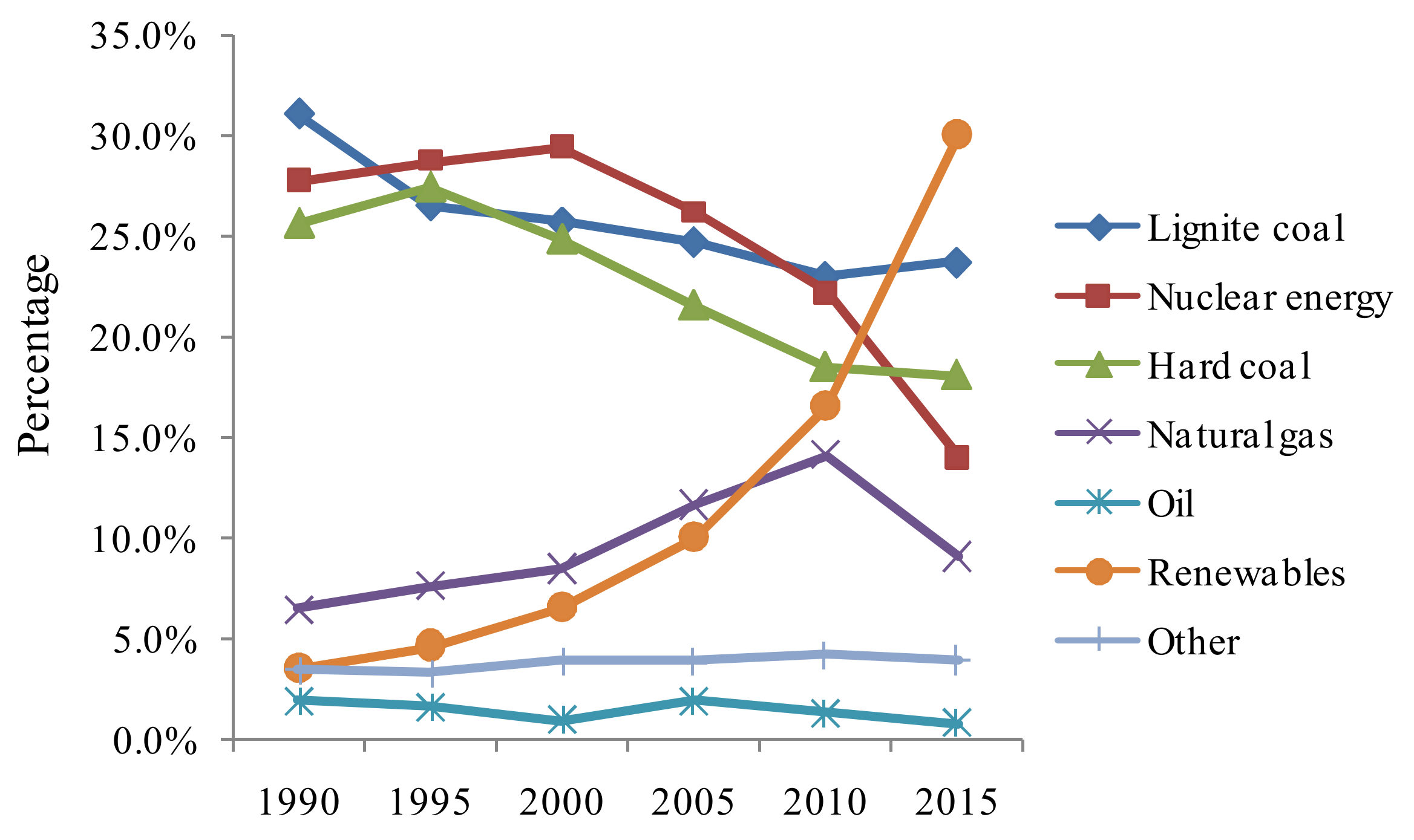
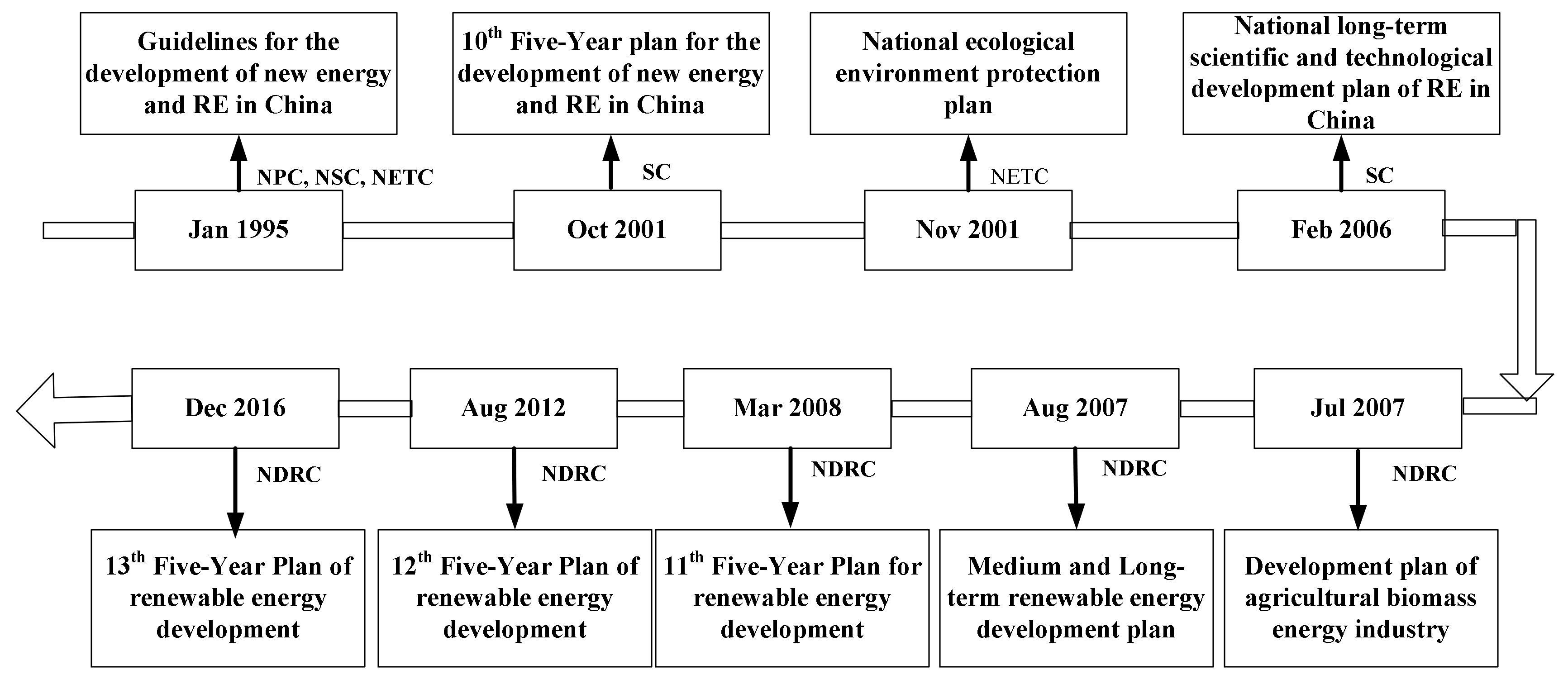
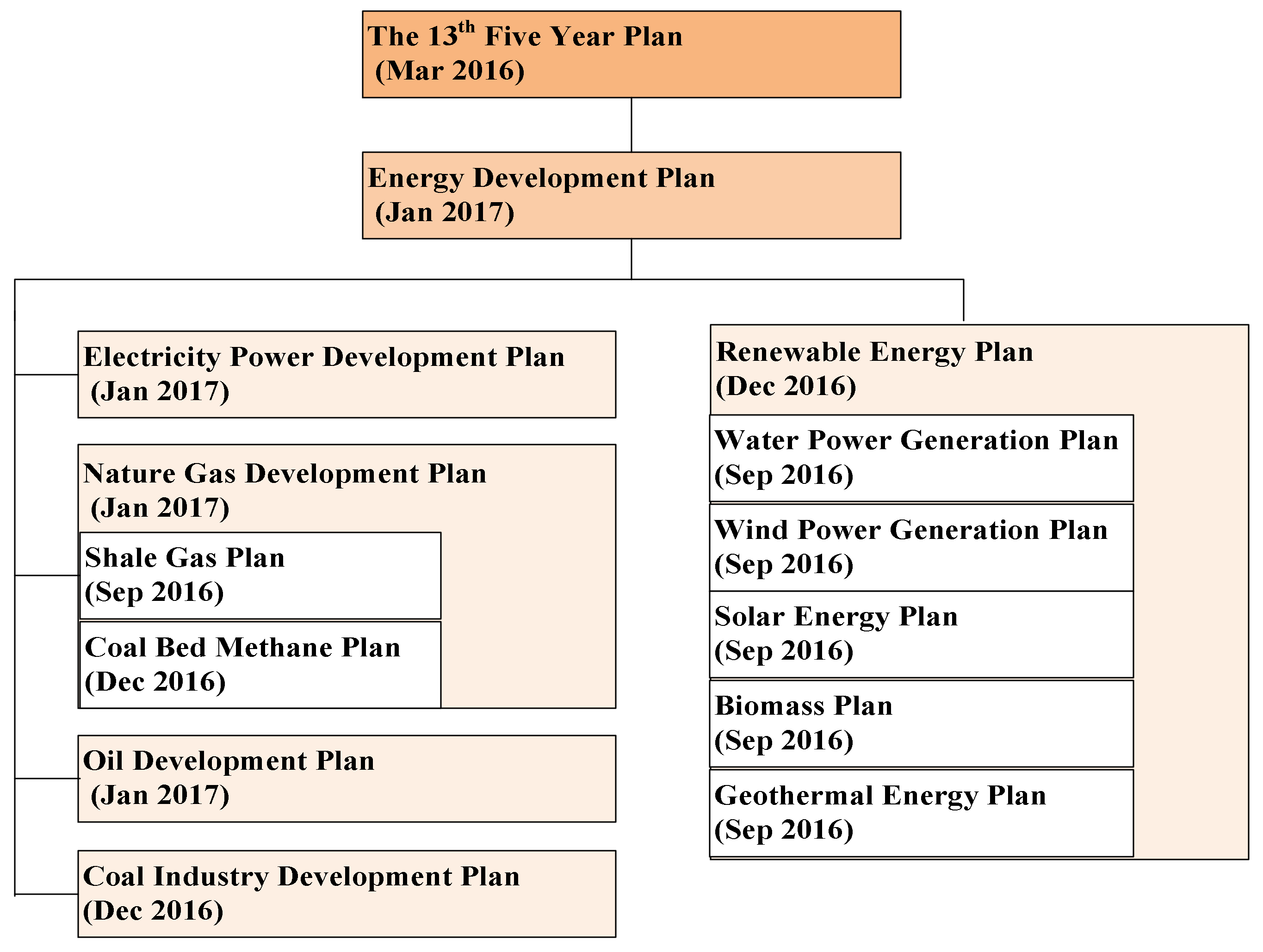
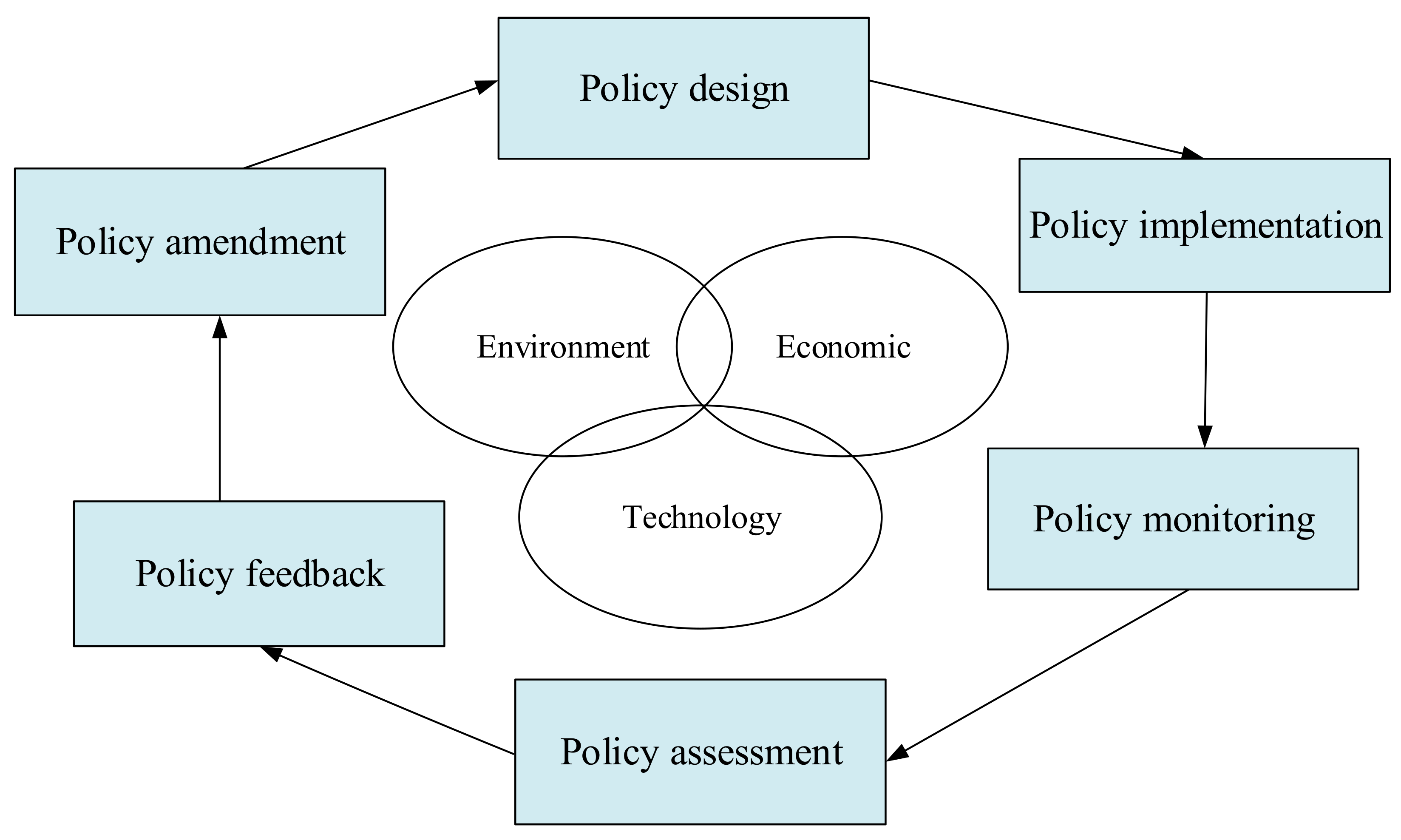
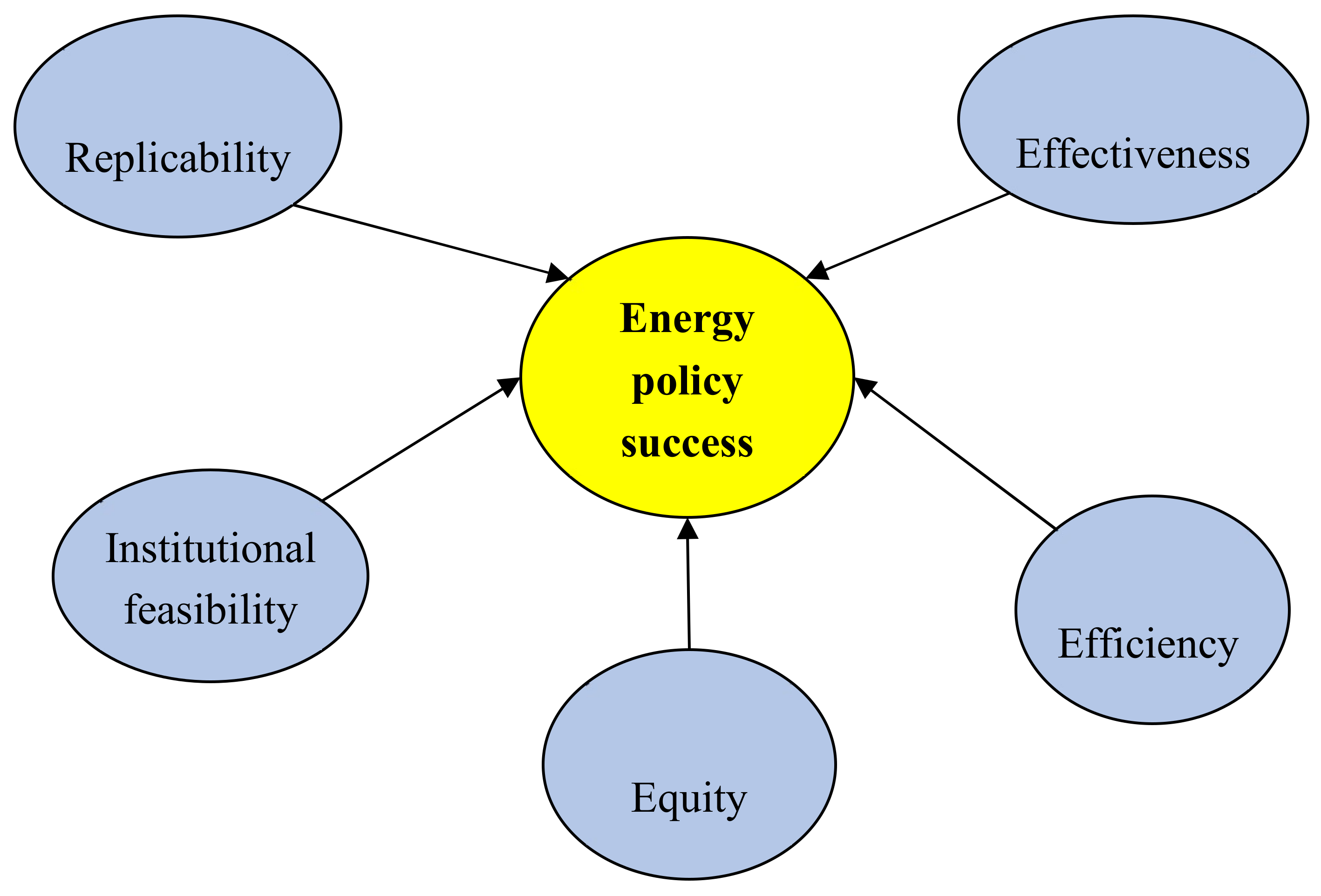

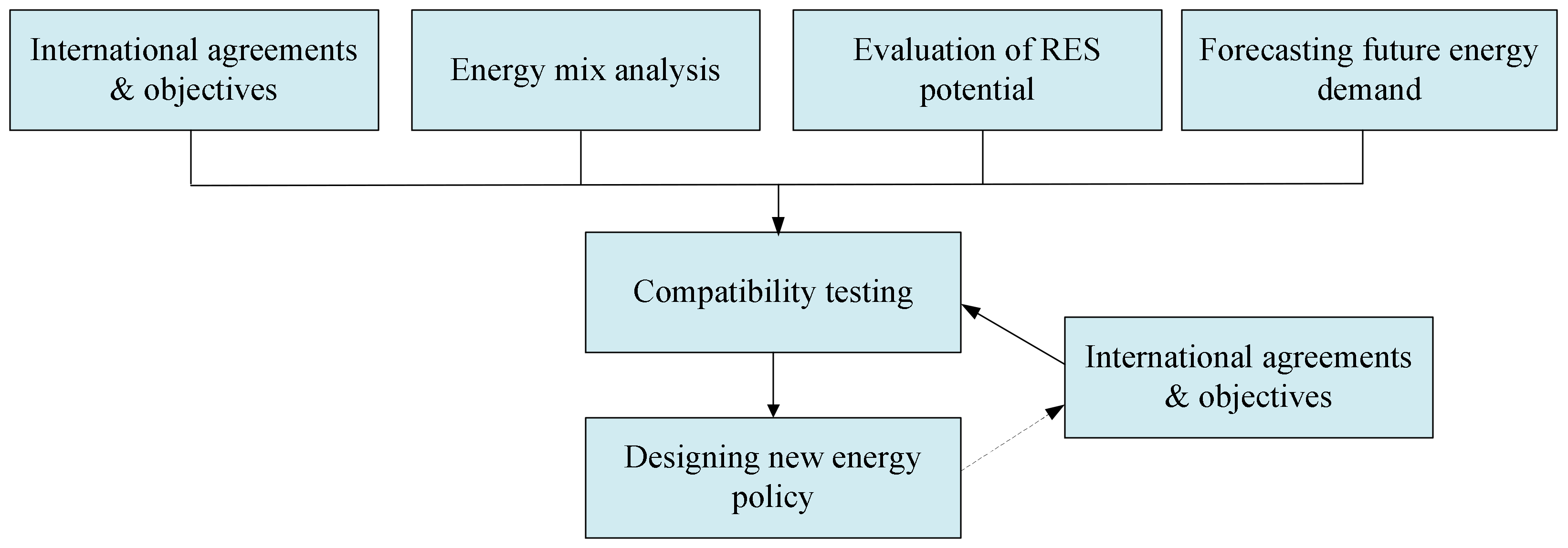

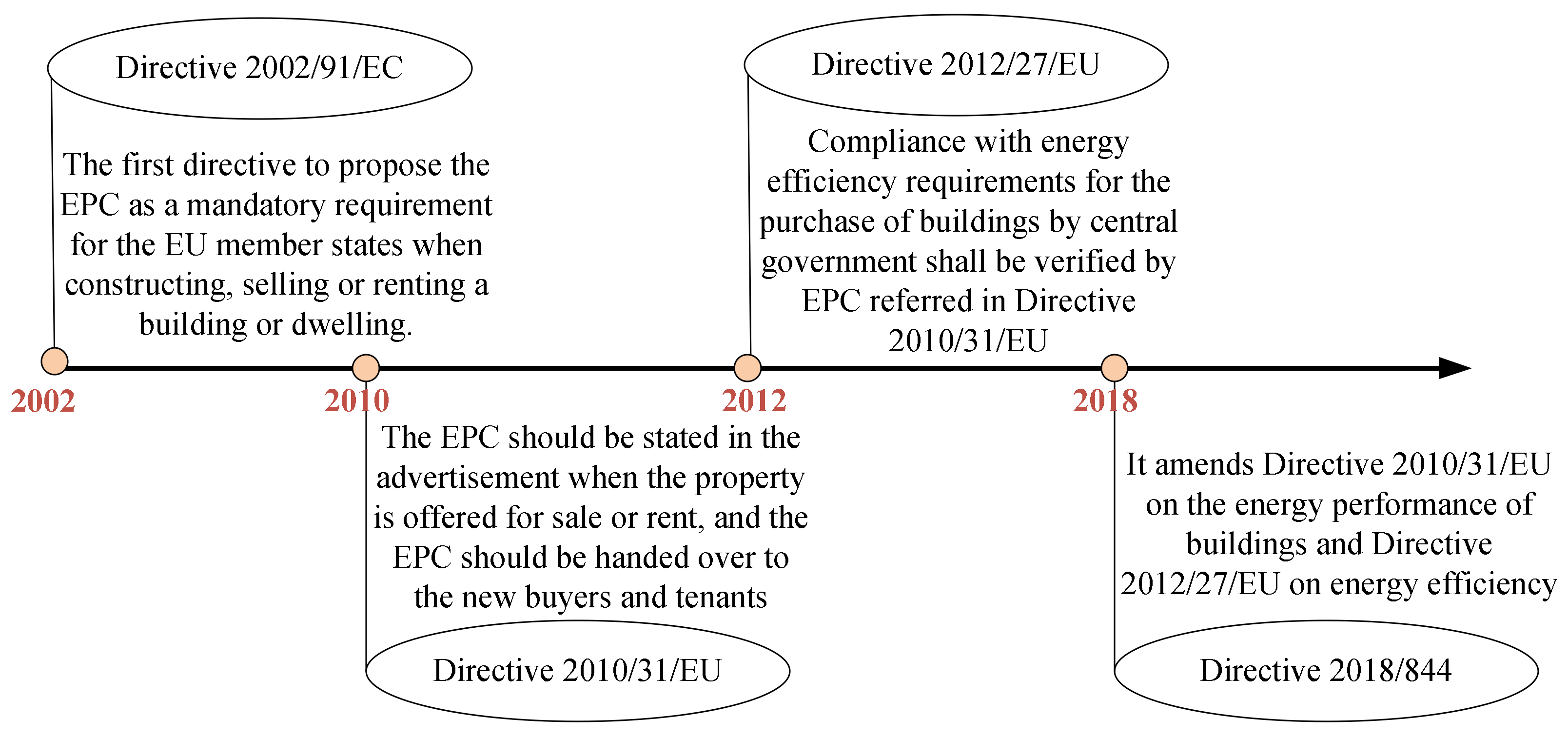


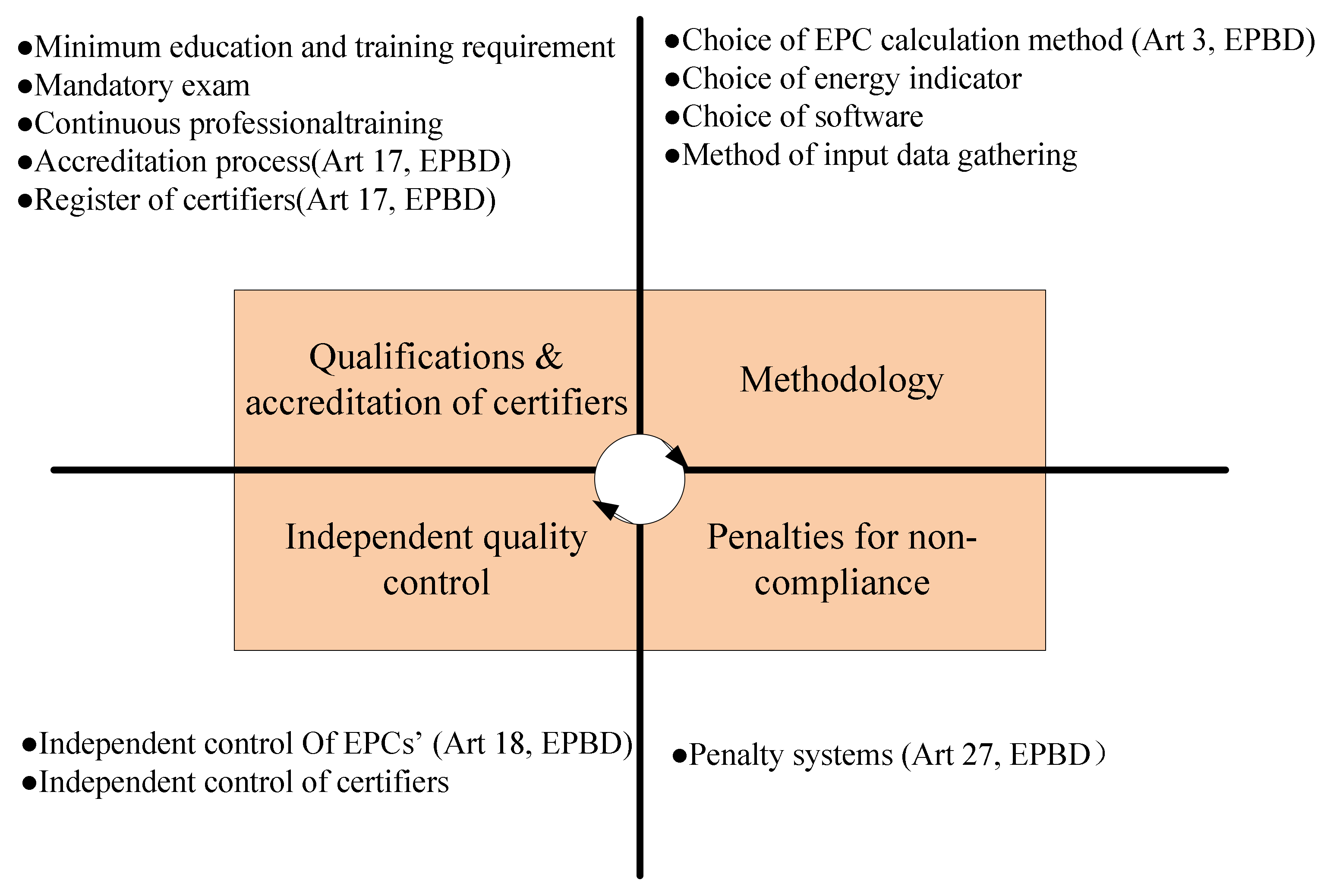
| Regulation | Description |
|---|---|
| EPAct 711,712,754 | Authorises Department of Energy (DOE) to accelerate efforts to develop hybrid electric and advanced diesel vehicles. |
| EPAct 751 | Authorises DOE research partnership with Department of Transportation (DOT) and Environment Protection Agency (EPA) to improve railroad efficiency. |
| EPAct 753, 758 | Authorises DOE, DOT, and NASA activities to improve the energy efficiency of aircraft. |
| EPAct 771, 774 | Authorises activities to fund implementation and enforcement of existing fuel economy standards and updating of testing procedures. |
| EPAct 1701-1704 | Authorises load guarantee program for innovative energy technologies including those for transportation energy efficiency. |
| EISA 102, 104 | Establishes new average fuel economy standards for automobiles and certain other vehicles and a trading program to allow manufacturers to earn credits when vehicles exceed standards. |
| EISA 131, 135 | Authorises DOE research and grant program for electric and hybrid electric vehicles and loan guarantees for the manufacture of advanced vehicle batteries and battery systems. |
| Regulation | Description |
|---|---|
| EPAct 102, 103, 109 | Establishes new energy reduction goals for federal buildings, including authorisation of metering for measurement and verification, and updated building energy performance standards. |
| EPAct 121–128 | Authorises new funding for state and local programs including weatherisation assistance, appliance rebates, grants to low income communities, and incentives for states to implement energy-efficient building codes. |
| EPAct 135 | Authorises development of energy conservation standards for additional products including, for example, fluorescent lamps, dehumidifiers, battery chargers, illuminated exit signs, vending machines, ceiling fans, and small package commercial air conditioning and heating systems. |
| EPAct 912, 913, 921 | Authorises new DOE programs in solid state lighting, building energy performance, and micro-cogeneration technologies. |
| EISA 301–316 | Authorises expanded set of standards for home appliances and building equipment including external power supplies, residential boilers, walk-in coolers and freezers, and procedures for expedited rulemakings, updated test procedures and regional approaches. |
| EISA 411–413 | Activities for residential buildings including reauthorisation of funding for weatherisation and energy code improvements for manufactured housing. |
| EISA 431–441 and 511–548 | Activities for federal and other government buildings including higher energy reduction goals, and authorisation for high-performance ‘‘green’’ federal buildings, new provisions for energy-saving performance contracting, streamlined procurement provisions, and block grants for state and local governments and Native American tribes. |
| Regulation | Description |
|---|---|
| EPAct 106 | Authorises DOE to establish a voluntary program in collaboration with industrial sector companies to make commitments to reduce industrial energy intensity. |
| EPAct 922 | Authorises DOE to establish a program to improve the efficiency of high-power density facilities including data centers, server farms, and telecommunications facilities. |
| EPAct 1701–1704 | Authorises load guarantee program for innovative energy technologies including those for industrial energy efficiency. |
| EISA 451 | Authorises DOE program to expand activities in waste energy recovery, district energy systems, and combined heat and power through funding for research and development, grants to the states, and outreach to decision makers using regional clean energy application centers. |
| EISA 452 | Authorises DOE programs to support energy-efficiency improvements in the energy-intensive industries through research, development, demonstration, technology transfer, and grants for innovative technologies. |
| EISA 453 | Expands authorities for activities to reduce energy consumption in energy-intensive data centers. |
| EISA 1002 | Authorises workforce training programs for ‘‘green jobs’’ including manufacturing of energy efficiency and renewable energy products through research and state programs. |
| Regulation | Description |
|---|---|
| EPA 139 | Authorises a study of energy-efficient electric and natural gas utilities. |
| EPA 921, 925, 925 | Authorises DOE programs for distributed energy and electric transmission and distribution through research, development, demonstration, analysis, and technology transfer. |
| EPA 1701–1704 | Authorises load guarantee program for innovative energy technologies including those for energy efficiency in electric power. |
| EISA 1301–1309 | Authorises programs for “smart grid” technologies, tools, and techniques through research, development, demonstration, technology transfer, cost-shared grants, and interoperability standards to enhance flexibility and functionality of grid operations and enable grid integration of demand response, conservation, energy efficiency, and renewable energy systems. |
| National Policy | Description |
|---|---|
| CERT—Carbon Emissions Reduction Target | Larger energy company supplier targets for energy-efficiency improvements via loft insulation and low energy light bulb distribution. Ended 2012 [35,36]. |
| CESP—Community Energy Saving Programme | Energy companies required to target low income households with improved energy-efficiency standards and lower bills. Additional credit for ‘whole house’ and community approaches. Ended in 2012 [35,36]. |
| Warm Home Discount | Financial support from electricity and gas suppliers for fuel poor households [37]. |
| CRC—Carbon Reduction Commitment | From 2012 large commercial organisations with consumption of more than 6000 MWh of electricity must pay CO2 tax initially set at £12/ton [38]. |
| Green Deal | Owner occupiers can borrow against future household energy bills to pay for home energy-efficiency improvements [35,36,37,38,39,40]. |
| ECO—Energy Company Obligation | From 2013, CERT and CESP replaced by three schemes. Carbon Emissions Obligation requires major suppliers to target ‘hard to treat’ households. Carbon Saving Community Obligation requires suppliers to support community energy-efficiency schemes such as District Heating. Home Heating Cost Reduction Obligations requires targeting of heat energy-efficiency measures (e.g., boiler replacement) on low income and vulnerable customers [38]. |
| FiT—Feed-in-Tariff | This is the renewable electricity generation support scheme for generators with capacity of less than 5 MW. This offers a fixed payment per kWh depending on size and type of technology [41]. |
| CfD—Contract for Difference | The renewable obligation (RO) scheme is due to be replaced by CfDs. This offers insurance payments equal to the difference between the average wholesale market price and a fixed strike price in the CfD for eligible large-scale renewable generation [42]. |
| RHI—Renewable Heat Incentive | From 2011 Renewable Heat Premium Payments were available to both non-domestic and domestic producers of renewable heat, providing partial support for those who install renewable heating systems. The domestic RHI budget was only £15 m in 2011/12 but the total RHI budget was £251 m in 2013/14 [43,44]. |
| The Renewable Obligation scheme | Suppliers meet their obligations by presenting Renewable Obligation Certificates (ROCs) to Ofgem. Where suppliers do not have sufficient ROCs to cover their obligation, a payment is made into the buy-out fund. The extension of the scheme from 2027 to 2037 was declared on 1 April 2010 and is detailed in the National Renewable Energy Action Plan [45]. |
| Shares and Targets | |
|---|---|
| In 1997 | 9% |
| Target for 2010 | 29% |
| Share in 2012 | 39% |
| National targets for renewable electricity | 50% by 2020; 100% by 2050 |
| Wind energy | Cumulative installed capacity: 4.7 GW; Target for 2020: 3.9 GW |
| Photovoltaic | Cumulative installed capacity: 0.548 GW Target for 2020: 0.006 GW |
| Building Energy Efficiency Standard | Key Points | |
|---|---|---|
| Design standard | Design Standards for Energy Efficiency of Residential Buildings in cold and frigid Zone (1986, 1995, 2010, 2018) | Provide specific requirement on energy saving from the aspects of building envelope, heating ventilation and air conditioning system (HVAC) for residential buildings in the heating area |
| Design Standard for Energy Efficiency of Residential Building in Hot Summer and Cold Winter Zone (2001, 2010) | Provide specific requirement on the thermal insulation performance of residential building envelope and energy savings in HVAC system | |
| Design Standard for Energy Efficiency of Residential Building in Hot Hummer and Warm Winter Zone (2003, 2012) | Provide specific requirement on the thermal performance of the wall and roof, the shading and heat insulation performance, and energy savings in HVAC system | |
| Design Standard for Energy Efficiency of Public Buildings (2005, 2015) | Applicable to all climate zones in China, provide specific requirement on energy-saving measures and requirements for different climate zones from the thermal insulation performance of building envelope and HVAC system | |
| Acceptance standard | Acceptance Specification for Construction Quality of Building Energy Conservation Projects (2007, 2014) | Provide specific requirement on related energy conservation projects (wall, curtain wall, door, window, roof, ground heating, ventilation, air conditioning, air conditioning and heating system, cold and heat sources, pipe network distribution and lighting monitoring and control), on-site inspection of building energy conservation project, and quality acceptance for part of the building energy conservation project, etc. |
| Commercial Building | Residential Building | |||
|---|---|---|---|---|
| Public Building (2015) [53] | Cold and Frigid Zone (2018) [54] | Hot Summer and Cold Winter Zone (2010) [55] | Hot Summer and Warm Winter Zone (2012) [56] | |
| Building Envelope | √ | √ | √ | √ |
| HAVC System | √ | √ | √ | √ |
| Hot water and Pump | √ | √ | × | × |
| Lighting | √ | √ | × | √ |
| Electricity | √ | √ | × | × |
| Tradeoffs and Building Performance Calculations | √ | √ | √ | √ |
| New Energy | √ | √ | √ | × |
| Modelling Methodology | Major Themes | Source |
|---|---|---|
| Linear programming and dynamic programing | Capacity expansion and energy-economy analysis | WASP model [64], and MARKAL model [65] |
| A mixed-integer linear program | Distributed energy resource system | MILP model [66] |
| Econometric methods | Annual energy outlook and the role of carbon capture and storage | NEMS model [67] and SGM model [68] |
| Partial equilibrium model | Develop the US Climate Action Plan | IDEAS model [69] |
| Optimisation | Energy-economy interactions and the options for SO2 control | Meier and Mubayi’s model [70] and Islas and Grande’ s model [71] |
| Scenario analysis | Energy policies | Munasinghe and Meier’s model [72] |
| Agent-based | Quantitative support for climate policy formulation and evaluation | ENGAGE model [73] |
| Country | Energy Regulation Name | Regulation Type | Stringency | Incentives | Energy-Efficiency Measures | |||||||
|---|---|---|---|---|---|---|---|---|---|---|---|---|
| Heating and Cooling | Design Guidelines | Construction Details Methodology | Wall and Ceiling Insulation | Air Sealing and Ventilation | Lighting Efficiency | Windows U-Value and SHGC | Other Installations | |||||
| Australia | BCA 2010-6 Star NatHERS Rating for Buildings [96] | SC | M | Y | Y | Y | N | Y | Y | N | N | Y |
| Brazil | Brazilian Energy Labelling Schemes for Residential Buildings (RTQ-2010) [97] | PU | V | N | N | N | N | N | N | N | N | N |
| Canada | National Energy Code of Canada for Buildings 2017 [98] | SC | Mi | Y | Y | Y | Y | Y | Y | Y | Y | Y |
| China | National Building Energy Standards [99] | PC | M | Y | Y | Y | Y | Y | Y | Y | Y | Y |
| France | RT2012 [100] | CC | M | Y | Y | Y | Y | Y | Y | Y | Y | N |
| Germany | EnEV 2014 [101] | PC | M | Y | Y | Y | Y | Y | Y | Y | Y | Y |
| Italy | EU Energy Performance of Buildings Directive (EPBD) 2018/844 [102] | PC | M | Y | Y | Y | Y | Y | Y | Y | Y | Y |
| India | State/city regulation in few states [103] | PU | Mi | N | Y | Y | N | N | N | N | Y | N |
| Japan | Energy Conservation Policy for Housing 2011 [104] | PU | Mi | Y | Y | Y | Y | Y | Y | N | Y | N |
| Mexico | 2009 New Mexico Energy Conservation Code [105] | SC | M | Y | Y | N | N | Y | N | Y | Y | N |
| New Zealand | New Zealand Building Code (NZBC)-Clause H1 [106] | CC | M | Y | Y | Y | N | Y | N | Y | Y | N |
| Russia | Presidental Decree 2012, State Programme on Energy Savings 2010 [107] | PU | M | Y | Y | Y | Y | Y | Y | Y | Y | N |
| South Africa | South Africa National Standard SANS 0204: Energy Efficiency in Buildings 2011 [108] | PC | M | Y | Y | Y | Y | Y | Y | Y | Y | Y |
| South Korea | Building Design Criteria for Energy Saving (BDCES) 2008 [109] | PU | M | Y | Y | Y | Y | Y | Y | Y | Y | Y |
| Spain | Technical Building Code 2007 [110] | PC | M | Y | Y | Y | Y | Y | Y | Y | Y | Y |
| UK | Building Code on Conservation of Fuel and Power 2018-Part L [111] | SC | M | Y | Y | Y | Y | Y | Y | Y | Y | Y |
| US | 2018 International Residential Code (IRC) [112] | SC | Mi | Y | Y | Y | Y | Y | Y | Y | Y | Y |
| Authors | Country/Region | Research Purposes |
|---|---|---|
| Lan et al. (2020) [120] | Australia | Apply a rigorous spatial econometric analysis model for the first time to evaluate the effectiveness of Australia’s household solar energy FiT policies. |
| Buckman et al. (2019) [121] | Australia | Compare the processes and outcomes of all 4 FiT reverse auctions conducted by the Australian Capital Territory Government between 2012 and 2016. |
| Schmidt et al. (2013) [122] | Austria | Analyze the effects of two different schemes (i.e., the fixed-price FiT and the premium based FiT) in a policy experiment for Austria. |
| Pacudan (2018) [123] | Brunei Darussalam | Assess policy options for the proposed 5-year rooftop solar PV deployment program in Brunei Darussalam targeting around 1000 households per year or installing a total of 50 MWp1(500,010 kWp) capacity in 5 years. |
| Moore et al. (2013) [119] | Canada | Use On-site data collection, interviews and financial models to determine the FiT rate required to encourage investment in the generation of electricity from currently unused biomass. |
| Zhang et al. (2019) [124] | China | Examine the effectiveness of the current wind FiT policy at a national-level. |
| Du et al. (2020) [125] | China | Investigate the effectiveness of regionally differentiated feed-in tariffs (FiT) for the development of renewable energy in China. |
| Kitzing (2014) [126] | Denmark | Identifies the risk implications of FiT. |
| Grover and Daniels (2017) [127] | England and Wales | Observe which socioeconomic groups are benefitting most and least under the policy. |
| Kwon et al. (2020) [128] | South Korea | Examine the effects of policy mix supporting electricity from renewable energy sources (RES-E) in South Korea. |
| Javier Ramírez et al. (2017) [129] | European countries | Provide a comparative cost effectiveness assessment using feed-in tariffs (FiT) and net-metering (NM) schemes in some representative EU countries. |
| Hitaj and Löschel (2019) [77] | Germany | Estimate the impact of a FiT on wind power investment and emission reductions in Germany from 1996–.2010. |
| Winter and Schlesewsky (2019) [130] | Germany | Investigate how the benefits (and burdens) of this subsidisation scheme are distributed by using micro-data from SOEP for private households during the period of 2010–17. |
| Caralis et al. (2016) [131] | Greece | Investigate the profitability range of offshore wind energy investments in Greece considering the uncertainties faced. |
| Tomar and Tiwari (2017) [132] | India | Discuss the feasibility of grid connected Rooftop/Building integrated photovoltaic (BIPV) system with incorporating feed-in-tariffs/net-metering process along with Tariff of day (ToD) tariff regulation. |
| Bakhshi and Sadeh (2018) [133] | Iran | Investigates the viability of Grid-connected photovoltaic (GCPV) technology under a new dynamic FiT strategy. |
| Lau et al. (2016) [134] | Malaysian | Analyze the effects of component costs, FiTs and carbon taxes on grid-connected PV systems in residential sector. |
| Marques et al. (2019) [135] | Spain | Analyze the impact of feed-in tariffs, feed-in premiums, and capacity payments on electricity generation by source. |
| Li et al. (2018) [136] | Taiwan | Illustrate the structure characteristics of the system dynamics (SD) model and offer suggestions to perfect the historical test proposed in the discussed paper. |
| Tantisattayakul and Kanchanapiya (2017) [137] | Thailand | Perform a feasibility analysis of grid-connected solar PV rooftops for households under the present feed-in-tariff. |
| Castaneda et al. (2020) [138] | United Kingdom | Investigate the long-term effects of cautious feed-in tariff reductions on household’s PV adoption, utilities and solar companies by considering a systems approach. |
© 2020 by the authors. Licensee MDPI, Basel, Switzerland. This article is an open access article distributed under the terms and conditions of the Creative Commons Attribution (CC BY) license (http://creativecommons.org/licenses/by/4.0/).
Share and Cite
Lu, Y.; Khan, Z.A.; Alvarez-Alvarado, M.S.; Zhang, Y.; Huang, Z.; Imran, M. A Critical Review of Sustainable Energy Policies for the Promotion of Renewable Energy Sources. Sustainability 2020, 12, 5078. https://doi.org/10.3390/su12125078
Lu Y, Khan ZA, Alvarez-Alvarado MS, Zhang Y, Huang Z, Imran M. A Critical Review of Sustainable Energy Policies for the Promotion of Renewable Energy Sources. Sustainability. 2020; 12(12):5078. https://doi.org/10.3390/su12125078
Chicago/Turabian StyleLu, Yuehong, Zafar A. Khan, Manuel S. Alvarez-Alvarado, Yang Zhang, Zhijia Huang, and Muhammad Imran. 2020. "A Critical Review of Sustainable Energy Policies for the Promotion of Renewable Energy Sources" Sustainability 12, no. 12: 5078. https://doi.org/10.3390/su12125078
APA StyleLu, Y., Khan, Z. A., Alvarez-Alvarado, M. S., Zhang, Y., Huang, Z., & Imran, M. (2020). A Critical Review of Sustainable Energy Policies for the Promotion of Renewable Energy Sources. Sustainability, 12(12), 5078. https://doi.org/10.3390/su12125078







